A comprehensive eye exam
What it includes?
- Talking about your personal and family medical history
- Taking vision tests to see if you have near sightedness, far-sightedness, astigmatism (a curved cornea that blurs vision), or presbyopia (age-related vision changes)
- Tests to see how well your eyes work together
- Eye pressure and optic nerve tests to check if you have glaucoma
- External and microscopic examination of your eyes before and after dilation.
- EYE CONDITIONS
- BACTERIAL CONJUNCTIVITIS:
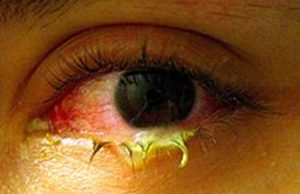
This is an inflammation of the conjunctiva, commonly due to a bacterial infection (Staphylococci and Streptococci).
SIGNS OF BACTERIAL CONJUNCTIVITIS
- Conjunctiva injection
- Chemosis
- Lid Edema
- Muco-purulent discharge
SYMPTOMS
- Red eye
- Discharge
- Tearing
- Light sensitivity
- Irritation, burning and stinging.
TREATMENT
Topical Antibiotics e.g. Chloramphenicol.
ALLERGIC CONJUNCTIVITIS
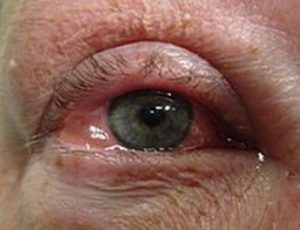
This is an inflammation of the conjunctiva as a result of allergy the most common cause is hay fever. It could also be seasonal. The symptoms are due to release of histamine and other active substances by mast cells which stimulate dilation of blood vessels, irritates nerve endings and increase tear secretion.
SIGNS/SYMPTOMS:
- Itching
- Tearing
- Eyelid swelling
- Photophobia
- Watery discharge
TREATMENT
- Topical Antihistamine such as Ketotifen –fumarate
-
- Dryness
- Sandy-gritty eye irritation
- Stinging
- Foreign body sensation
- Redness
- Sensitivity to bright light
- TearingDRY EYE SYNODROME
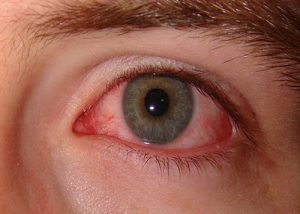
Kerato-conjunctivitis sicca, this is caused as a result of dryness of the eyes, which in turn is caused by enter decreased tear production or increased tear film evaporation. Symptoms are increased by activities in which the rate of blinding is reduced due to prolonged use of the eyes this include prolonged reading, computer usage, driving watching TV, it could also increase in windy, dusty or smoky areas, in dry environments i.e. in areas where an air-conditioner or fan is used.SYMPTOMS AND SIGNS
TREATMENT
- Use of Artificial tears
PTERYGIUM
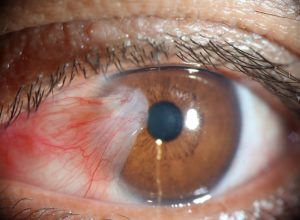
- Pterygium (surfer’s eye) refers to a benign growth on the conjunctiva, it is associated with and thought to be caused by ultra-violent exposure e.g. sunlight, low humidity and dust. In advanced cases. Pterygium can affect the vision as it invades the cornea with the potential of obscuring the optical centre of the cornea and inducing Astigmatism and cornea scaring.SIGNS AND SYMPTOMS
- Persistent redness from smoke
- Inflammation
- Foreign body sensation
- Tearing
- Dry and Itchy eyes
TREATMENT
- Short course of steroid eye drops
- Surgical Excision
- Adequately protect your eyes from excessive UV light
- Protect your eyes in dry dusty condition with proper eye wear
-
- Open-angle glaucoma is painless and doesn’t have acute attacks, thus the lack of clear symptoms make screening via regular eye check-ups important. The signs are gradually progressive visual field loss and optic nerve damage.
- About 10% of people with closed- angle glaucoma is usally characterised by sudden ocular paon, seeing halves, red eye, high intra ocular pressure, nausea, vomiting, suddenly decreased vision, a fixed-dilated pupil.Artificial tears
GLAUCOMA
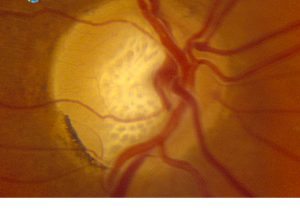
It is a group of diseases which result in damage to the optic nerve and vision loss as a result of increased intra-ocular pressure. The progression is usually slow and it is also a symptomatic. It can permanently damage vision in the affected eye first by decreasing peripheral vision and the potentially leading to blindness if left untreated. Positive family history is a risk factor for glaucoma, various rare congenital/genetic eye malformations are associated with glaucoma. Other causes include prolonged use of steroids, severe diabetic retinopathy and central retinal vein occlusion and ocular trauma.SIGHS AND SYMPTOMS
TREATMENT
- Use of anti-glaucoma drugs such as: i) Prostaglandin analogs- latanoprost, bimatoprost, travopost. ii) Topical beta-adrenergic recetor antagomst. iii) Carbonic anhydrase inhibitors.
